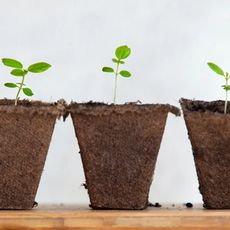Everything You Need To Know About Holiday Waste

Written by Allie Willison, Customer Experience @Blueland
December 21, 2020
The Holidays are here! Turkey, mashed potatoes, presents, family time– it really is the best time of the year. But as we fall into our post Holiday meal food coma, do we think about how much waste is being produced from our festivities?
Studies have found that waste increases by 25% between Thanksgiving and New Years in the U.S. But what can we do to minimize what ends up in a landfill while we’re sipping on eggnog and getting ready to (finally) ring in the New Year?
Holiday Food Waste
While we all love the big Norman Rockwell table setting it’s important to be mindful of how much of that food is being eaten, and how much is getting tossed out.
If all the world’s food waste got thrown together to make a new country, it would be the 3rd largest producer of greenhouse gasses– right behind China and the United States.
Individually, we can’t really be completely blamed. Half of all food waste happens during production, before the food even leaves the farm in most countries. However, a recent study by RedFed shows that in the United States, 85% of food waste happens in restaurants, stores, or the home. Many factors play into this, from insufficient refrigeration to misleading food labeling. Luckily, some US Policymakers are working on policy to fix the label problem, but in the meantime, we can all be more aware as to what that scratchy date stamped on our food really means.
Also, keep in mind the kind of food you’re purchasing or consuming as you prep your holiday meal. Meats and cereal crops emit loads more emissions than plant-based foods. Over half of all food-based emissions (58%) comes from animal products, while half of that comes directly from beef and lamb animal farming. Though meat is wasted much less than other foodstuffs (only about 5% of all food waste), it takes a lot of energy to produce, so the damage is more extensive when it’s tossed.
What more can you do?
Americans love to eat, we love to cook, and share meals, especially in the upcoming Holiday season. Shop local, small farmers markets or local shops take away the middleman where waste can be produced unnecessarily. The second best thing we can do to keep our waste down is to plan ahead and not overdo it. I’m sure we’ve all heard the joke where one Aunt always “cooks enough to feed an army”, but this year try to balance the portions closer to just enough to feed the whole crew. If you overshoot, put together leftover containers for everyone, freeze food for a later date, and have some leftover recipes ready to go for the next week!
Are Christmas Trees Wasteful?
The Christmas Tree all decked out as it lit up the room. It’s a staple, a tradition dating back to Germany in the 16th century. It’s the hallmark of Christmas for most of us– that big moment when you turn on the lights and watch the green branches sparkle among the lights.
But what’s better to keep the environment sparkling too? A real tree or an artificial tree? Both have their pros and cons.
Are Real Trees Wasteful?
Real trees are produced in farms, much like any other crop, and are replanted each year. One downside of this is that farmers can sometimes use pesticides which are harmful to the environment. Also, the tree can only be used once and for one holiday season. The bright side to this being that they’re fully compostable or can be ground into mulch. Win, win.
Are Artificial Trees Wasteful?
Artificial trees have their ups and downs too. They can be reused for years and years. They also tend to be much less expensive than real trees and you save on having to go to a tree farm to purchase. However, they’re usually made of plastics and metal that are hard to recycle if discarded. Plus, because they’re made of these materials they’re often sprayed with flame retardants that are harmful to the environment when the tree is disposed of as it can leach out of the plastic and into our waterways or soil.
So which is greener? The American Christmas Tree Association claims that if you use an artificial tree for more than 5 years, it’s more environmentally sound than chopping down a real tree every year. However, many farmers argue that the energy emitted during the production of those trees outweighs the pros, and at the end of the day they still end up in a landfill.
How Much Do We Waste With Holiday Gifts?
How many times have you been unwrapping a gift, only to open it and put on an Oscar-worthy performance of “Wow! I love it!”? We spend upwards of $15 billion dollars on unwanted gifts each year. So how do we avoid this?
The top culprits of unwanted gifts are clothing and accessories, making up 43%. Right behind those are household items at 20% and then cosmetics or fragrances at 12%. It seems the safest avenues are music (at only 4%) and food or drink (also around 4%). Who doesn’t love to eat while jamming to some fun tunes?
Ways to Reduce Waste When Gifting:
Of course, it’s always good to keep in mind that gift-giving is about the personal connection you have with your loved ones. Here are some great ways to keep your footprint low when gearing up to gift:
- Gift cards– Easy to get last minute, almost every retailer sells them, and if you’re not sure which store they’d like you can get a generic gift card like Visa!
- Experiences or services– Tickets to a concert/museum/show (when they come back), a nice meal, or a limited membership for online classes from something like SkillShare! Better yet, get two so you can do it together.
- Homemade Gifts– Sometimes the best things are the ones made by our own hands, if you’ve gathered a new skill this year while we stayed home, put it to use! Not to mention, it’s sure to make mom cry.
- Shop locally– So many of our emissions come from shipping and though there are ways to lessen your footprint when shopping online (Learn more in our Singles Day Post, here), it’s always great to support items made locally!
- Shop sustainably– Gift items that will help your loved ones reduce their daily footprint and encourage them to live greener too.
Check out our
While gift-giving is a part of the tradition, it can be shifted to be more environmentally conscious and that only happens when we start a new tradition. At the end of the day, the holiday season is about quality time and being together, the rest is just extra icing.
How Much Do We Waste Wrapping Gifts?
As you gather up all those gifts from the list above to wrap, keep in mind that gift wrapping leaves a lot of trash behind. Every year, Americans throw away 38 Million miles of ribbon, that’s enough to wrap enough around the entire planet with some to spare for a bow.
Unfortunately, most commercial wrapping paper isn’t recyclable and about 2.3 million pounds of it ends up in the landfill each year. If it passes the “scrunch test” you can most likely recycle it, crunch it into a ball and if it says that way it passes. But if it has that shiny coating or glitter of any kind it can actually be a recycling contaminant. Other holiday staples like cards, gift tags, ribbons, and adhesives also contribute to the amount of waste.
Tips for Low Waste Wrapping:
- Gift cards– Since it’s a card or in some instances can be e-mailed, there’s no need for wrapping!
- Try cloth wrapping materials and techniques that you can use again and again!
- Jars, tins, pouches, and reusable bags– All of which encourage sustainable practices!
- Boxes on their way to recycling– Spruce them up with paint or markers and pluck a sprig off your tree to give them that Pintrest class!
- Forgo the wrapping all together– Let the gift speak for itself!
Read more about
How Much Energy Do We Waste During The Holidays?
The last thing we think about during the hustle and bustle of the Holidays is how much energy we’re using to keep our decor lit up every night or cook our favorite meals. But in the past years the United States has used more energy on Christmas lights alone than other countries use year round.
How can we save on energy when we’re trying to juggle a million other things? Here are some tips:
- Reduce your fuel consumption– Carpool with friends and family to events, unload your car completely after your shopping trip, and do one big trip if you’re able! The less time you spend driving, the less fuel you use. Plus it can save you money too!
- Before winter sets in check out your home for maintenance issues– Insulate your windows, make sure your fireplace is cleaned and sealed, and invest in good curtains to keep the warmth in at night, while keeping them open during the day to let the sunshine warm your home. These can help save the amount of fuel you need to heat your home!
- Decorate with energy in mind– Use a power strip for what you use to deck the halls, so you can turn them all off at once when you leave. Or invest in LED lights, they use 70% less energy than standard incandescent lights. Use a light timer to let the holiday spirit shine just long enough, but not too much.
- Electric-free decor– Try getting creative and seeing what you can do without electricity or flashing lights. Using trimmings from the tree is a personal favorite of mine, I set them on my mantle instead of lining it with lights– giving it a cozy charm!
- Save energy in the kitchen– Though you’re in the kitchen a lot between big meal preps (making just enough) and cookie decorating, small steps like using the right size pot or using our oven light instead of opening the door and letting out the heat can save energy in the long run!
By incorporating some of the tips above into your Holiday season, you can help to get that 25% down. Making this year the season of cheer and no waste!


